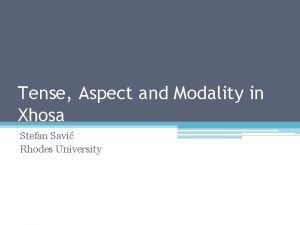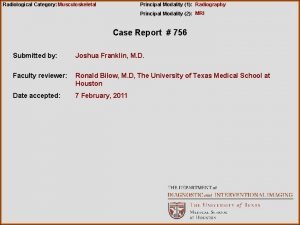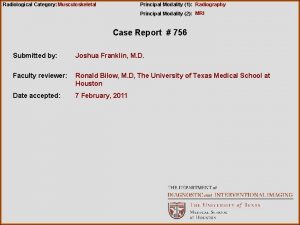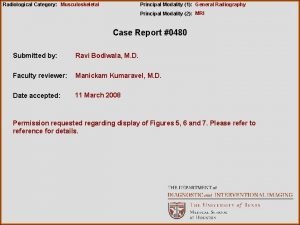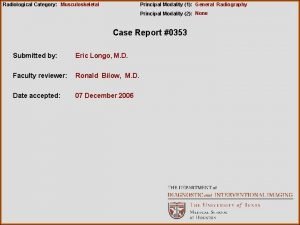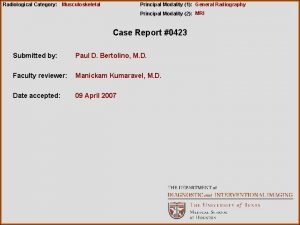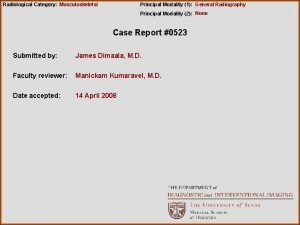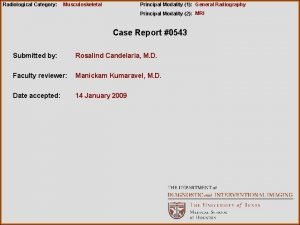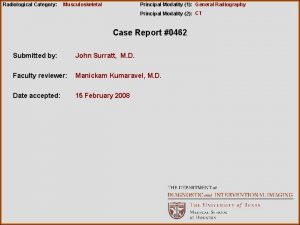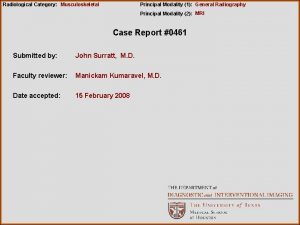Radiological Category Musculoskeletal Principal Modality 1 General Radiography











- Slides: 11

Radiological Category: Musculoskeletal Principal Modality (1): General Radiography Principal Modality (2): None Case Report #0412 Submitted by: Susanna Spence, M. D. Faculty reviewer: Manickam Kumaravel, M. D. Date accepted: 12 April 2007

Case History 59 year old Hispanic male was walking up a flight of stairs into his house when he slipped and fell, sustaining his injuries. In addition to the films shown here, the patient had a T 7 compression fracture. He has no history of HTN, DM, CAD, or renal failure. His WBC count is normal at 8. 4

Radiological Presentations

Radiological Presentations

Test Your Diagnosis Which one of the following is your choice for the appropriate diagnosis? After your selection, go to next page. • Unicameral bone cyst • Aneurysmal bone cyst • Fibrous dysplasia • Intraosseous lipoma • Brodie’s abscess • Calcaneal pseudotumor

Findings and Differentials Findings: A 1. 9 x 2. 1 cm osteolytic lesion within the calcaneus with a sclerotic border and central “bullseye” calcification. No surrounding bony expansion or periosteal reaction. The patient also has a calcaneal fracture from his fall. Differentials: • Calcaneal pseudotumor • Intraosseous lipoma • Unicameral bone cyst • Aneurysmal bone cyst • Fibrous dysplasia • Brodie’s abscess

Discussion An osteolytic lesion with a sclerotic margin involving the anterior portion of the calcaneus with a central “bullseye” calcification, and no surrounding bony expansion or periosteal reaction. The central or ring-like appearance of calcification is said to be pathognomonic for intraosseous lipoma of the calcaneus, and can be used to distinguish the lesion from ABC. Bone scan is noncontributory in the case of a simple calcaneal lipoma. Some sources believe that intraosseous lipomas represent an "overshoot" phenomenon that develops during the transition of hematopoietic to fatty marrow in areas that have relatively little trabecular bone. They postulate that these lesions should be considered hamartomas rather than neoplasms. Milgram presented a classification system for intraosseous lipomas: Stage I representing a simple, lytic appearance of radiograph, pathologically representing viable fat cells Stage II as seen in this example, represents partial necrosis and calcifications Stage III involves necrotic fat by pathology, more extensive calcification of necrotic fat by radiograph, and cyst formation.

Discussion Other diagnostic possibilities: Unicameral bone cyst: a common location is in the anterior portion of the calcaneus, and it will appear as an osteolytic lesion with a sclerotic rim, and benign appearance. It will not have a central bullseye calcification. A “fallen fragment” sign is unusual in this non-weight-bearing location. Aneurysmal bone cyst: usually expansile. CT will generally show fluid-fluid levels within the lesion. There is no central calcification. Fibrous dysplasia: “ground glass” matrix, expansile, may be multiloculated Brodie’s abscess: unlikely in an asymptomatic patient with a normal white count and no surrounding bony destruction or periosteal reaction. A bone scan would be positive in these patients. Calcaneal pseudotumor: a relative paucity of bony trabeculae can occur in this non -weight-bearing portion of the calcaneus, causing a relatively lucent appearance and calcaneal “pseudotumor. ” A pseudotumor does not have a sclerotic rim or central calcification.

Findings and Differentials Calcaneal pseudotumor Chronic osteomyelitis

Diagnosis Intraosseous lipoma

References Murphey, MD et al. : Benign Musculoskeletal Lipomatous Lesions, Radio. Graphics 2004; 24: 1433 -1466. Brandt and Helms, Fundamentals of Diagnostic Radiology, 2006, pp 1064 -1085 Milgram, JW: Intraosseous lipomas: Radiologic and Pathologic Manifestations, Radiology 1988: 167: 155 -160
 Pa erate
Pa erate Center for devices and radiological health
Center for devices and radiological health National radiological emergency preparedness conference
National radiological emergency preparedness conference Radiological dispersal device
Radiological dispersal device Tennessee division of radiological health
Tennessee division of radiological health Pacs modality workstation
Pacs modality workstation Past tense in xhosa
Past tense in xhosa Sensory modality examples
Sensory modality examples Modality in software engineering
Modality in software engineering Deontic modality
Deontic modality Modality in software engineering
Modality in software engineering Cardinality and modality
Cardinality and modality






